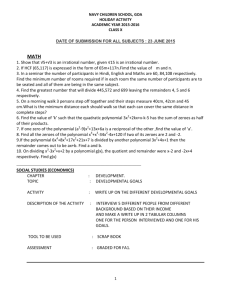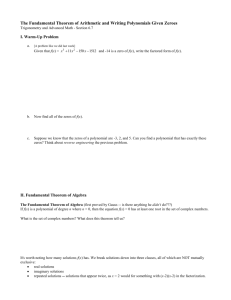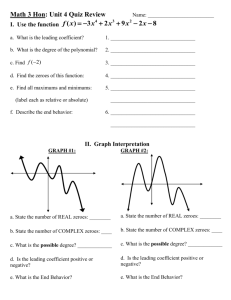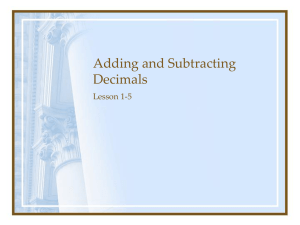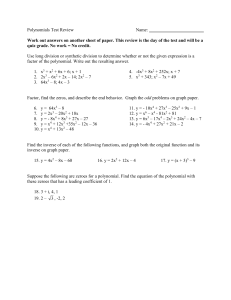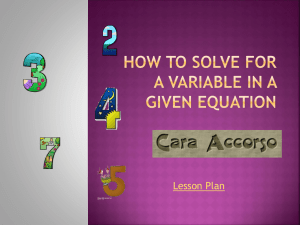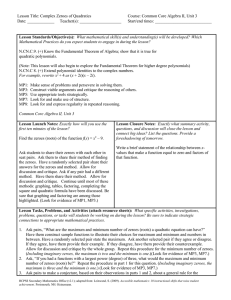FR. AGNEL SCHOOL, GAUTAM NAGAR SUMMER HOLIDAY
advertisement
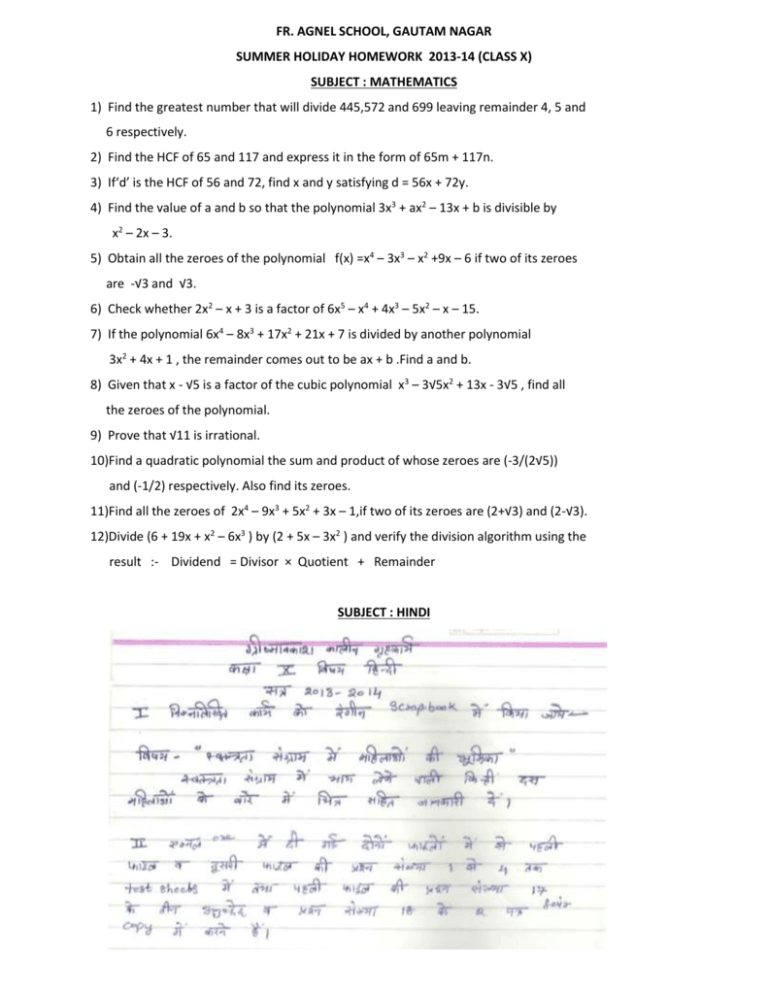
FR. AGNEL SCHOOL, GAUTAM NAGAR SUMMER HOLIDAY HOMEWORK 2013-14 (CLASS X) SUBJECT : MATHEMATICS 1) Find the greatest number that will divide 445,572 and 699 leaving remainder 4, 5 and 6 respectively. 2) Find the HCF of 65 and 117 and express it in the form of 65m + 117n. 3) If‘d’ is the HCF of 56 and 72, find x and y satisfying d = 56x + 72y. 4) Find the value of a and b so that the polynomial 3x3 + ax2 – 13x + b is divisible by x2 – 2x – 3. 5) Obtain all the zeroes of the polynomial f(x) =x4 – 3x3 – x2 +9x – 6 if two of its zeroes are -√3 and √3. 6) Check whether 2x2 – x + 3 is a factor of 6x5 – x4 + 4x3 – 5x2 – x – 15. 7) If the polynomial 6x4 – 8x3 + 17x2 + 21x + 7 is divided by another polynomial 3x2 + 4x + 1 , the remainder comes out to be ax + b .Find a and b. 8) Given that x - √5 is a factor of the cubic polynomial x3 – 3√5x2 + 13x - 3√5 , find all the zeroes of the polynomial. 9) Prove that √11 is irrational. 10)Find a quadratic polynomial the sum and product of whose zeroes are (-3/(2√5)) and (-1/2) respectively. Also find its zeroes. 11)Find all the zeroes of 2x4 – 9x3 + 5x2 + 3x – 1,if two of its zeroes are (2+√3) and (2-√3). 12)Divide (6 + 19x + x2 – 6x3 ) by (2 + 5x – 3x2 ) and verify the division algorithm using the result :- Dividend = Divisor × Quotient + Remainder SUBJECT : HINDI SUBJECT : BIOLOGY BIOLOGY PROJECT – 1) An individual investigatory project on either Digestive or Respiratory disorders related to present day lifestyle . A fairly detailed Project report should be submitted ( hard copy ) by 15th July. 2) An assignment on nutrition and respiration given to the students in the class. SUBJECT : PHYSICS Students are required to do an activity/Project on topic Electricity OR Magnetic effects of current. The project can be done in groups in which a group should have a maximum of five students. This project can be done in groups and each group should have a group leader. There has to be a report of the activity/project. The format of the report is as follows: 1. 2. 3. 4. 5. Name of the activity/project. Name of the group members. Theoretical Concept/ Principle involved. Brief description of activity/Procedure Involved Conclusion/ Result. Group leaders are required to give or send the name of students doing a particular project to their teachers. They can either do it personally or send a mail to their concerned teachers regarding this matter. This is not a project which requires a copy from the net, you have to think in an innovative manner and come up with some application of the various topics that you have studied. SUBJECT : CHEMISTRY NOTE 1. Project to be done in A4 size coloured sheet. 2. Photographs of the experimentation to be attached where ever possible. 3. FORMAT :SHEET 1 1.) Childs photograph while performing the experimentation 2.) Class and section 3.) Roll no. 4.) Session 2013-14 5.) FA II - activity SHEET 2 AIM - To prepare a natural indicator using one of these Red cabbage extract China rose Turmeric and note down the colour change for the following: o o o o o o o o o Bottle gourd Ridge gourd Bitter gourd Tomato Potato Tea Coffee Vinegar Lemon o Raw mango o Ripe mango o Apple o Litchi o Sweet lime o Coconut water o Aerated drink o Tamarind o Soap solution o Salt o Sugar And conclude whether the substance is acidic , basic or neutral S.No. SUBSTANCE COLOUR OF INDICATOR IN ACIDIC BASIC NEUTRAL 1 2 SO ON On the basis of your experimentation explain: Why should we avoid aerated water. Why genrally we have stomach ache or burning sensation on having gol gappas/chaat. When food stain is washed with soap it turns red. NOTE: Take out juices of vegetables to check their nature. SUBJECT : CHEMISTRY 1. Read the complete story, ‘The Diary of a Young Girl’ and attempt one of the following on ruled sheets. a) Comment on the relationship between the father and young Anne. (200 words) OR b) Compose a brief poem based on Anne Frank. Provide a suitable title for the same. Try including poetic devices, imagery, a rhyme scheme etc. to your poem. 2. Find out about the herb mentioned below (according to your roll No.) and present your findings in the form of charts or a P.P.T. discussing its botanical name (if any), origin, region of growth, advantages, medicinal properties (if any) etc. R. No.1- Aloe vera 2.- Acai berry 3- Alfalfa 4- Arnica 5- Lemon grass 6- Barberry 7- Bay leaf 8- Bitter gourd 9- Bitter orange 10- Blueberries 11- Chili peppers 21- Fenugreek 31- Mint 41- Tea tree oil 12- Wheat grass 13- Celery 14- Cayenne 15- Chamomille 16- Cinchona 17- Clove 18- Cranberry 19- Dandelion 20- Eucalyptus 22- Flaxseed 23- Garlic 24- Ginger 25- Gingko 26- Ginseng 27- Grape 28- Guava 29- Hawthorn 30- Lavender 32- Thyme 33- Turmeric 34- Ajwain 35- Licorice root 36- Marigold 37- Papaya 38- Oregano 39- Neem 40- Lemon 42- Tulasi 43- Basil 44- Avocado leaf 45- Opium Poppy 46- Asafoetida 47- Sage 48- Cinnamon 49- Rosemary 50- Peppermint 3. Attempt all the integrated exercises in the work book. 4. Read the newspaper every day, clip and collect articles in a file/ folder related to the following topicsHealth and medicine Education Science Environment Travel and tourism National integration SUBJECT : FOUNDATION OF INFORMATION TECHNOLOGY Q1. Explain the following terms – (a) E- banking (b) E-reservation (c) E- learning (d) E-shopping (e) E-groups (f) Social Networking (Do the above question in your notebook) Q2. Revise the following chapters: 1. Internet 2. Internet Services Q3. Do the given worksheets and paste in the notebook. Q4. Make a project on the topic “Internet Services”. Use A4 size pastel sheets. You must include at least 4 internet services. Include screen shots of various web pages related to each service SUBJECT : GEOGRAPHY Class 10 Project Topic: Women and Development Instructions: The following seven points on the status of women would give you an idea about the present status of women in India and help you to develop some idea about the position of women in our society. You are advised to read further regarding some recent developments that took place with special reference to women and try to get a deeper insight into the position and power women wield in this modern democratic state. The process of development cannot move forward until equality is achieved between sexes. After reading the following six points and some more readings you are required to answer some questions briefly in your own words (100-150 words). Questions are given at the end. 1. Focus on India India ranked 95 according to Human Development Report, 1998 and 104 by 2000. Strategies for emancipation of women did help in improving the status of women world around to a considerable extend. The special session of the UN in the year 2000Beijing) makes an evaluation of the achievements made by the member states towards the goal of status enhancement of women. 2. 2. Starting of 19th Century Social reformers and missionary educationists, with the active support of the colonial state, made efforts to provide opportunities for women's education. This led to the expansion of schools and the recruitment of women teachers. At the same time, there was considerable debate during the reform movement regarding women's education and its purposes. Efforts were made not only to provide women the educational opportunities but it was coupled with other struggles against child marriage and the practice of sati and for the promotion of widow remarriage, and general change in people's attitudes. The efforts of social reformers and missionaries laid the foundation for the development of public education for women. Gradual changes began with the involvement of women in large numbers in the freedom movement. This necessitated some redefinition of their gender roles. There was recognition of the public roles of women. Mahatma-Gandhi played an important role in channelizing women's role in the freedom struggle, which meant involvement in the public domain. In the final analysis he too advocated women's education essentially to improve their traditional roles as wives and mothers within the patriarchal family. 3. Constitutional Provisions in India • • Article 14 : “… equal rights and opportunities to men & women…” Article 15 : “… prohibits discrimination on any ground ..” “ … renounce the practice derogatory to women’s …” “ … right to means of livelihood to men and women …” “ … equal pay for equal work …” • Article 24 : “… no child below the age of fourteen years shall be employed to work…in any other hazardous employment” • Article 39 : “… the tender age of children are not abused…” “…to enter avocations unsuited to their age of strength…” • Article 39 (c) directs the State to ensure equal pay for equal work. • Article 42 : “… provision for just and human conditions of work and maternity relief…” Article 44 advocates for a uniform civil code for the citizen. Article 73 : “… participation of women in the political and grassroots & 74 development process …” • Article 45 provides for free and compulsory education to all children upto the age of 14 within 10 years of coming into force of the Constitution. • Article 47 highlights that the State is further committed to raising nutritional levels and health and living standards of the people. 4. Empowerment of Women Enhance self-esteem and self-confidence of women Build a positive image of women Developing ability to think critically Fostering decision making and action through collective processes. 5. Gender Specific Programmes and Interventions Department of Women and Child Development Gender-specific interventions Balika Smriddhi Yojana Adolescent Girls Scheme Integrated Child Development Services Programme Kishori Shakti Yojana Department of Education District Primary Education Mahila Samakhya Department of Health and Family Welfare Reproductive and Child Health Programmed 6. Present Scenario Gloomy Side Even after more than 60 years of our independence a vast segment of the female population in India remains illiterate. Though the percentage of literacy has increased among women in India over the years. The female literacy rates in India are greatly constrained by the dropout rates among girls, especially at the upper primary and secondary levels. In rural India for every 100 girls who enrolled in class 1 only one enters class XII. In urban areas it is 14 girls at that level. Out of 100 girls enrolled in class 1 less than 40 joins class V (The number of girls per 100 boys is also low especially at the higher education level). 7. General Note (Conclusion) Male and female discrimination, work, power and the family are complicatedly intertwined. Mainly cultural ideologies cause gender inequalities, which contribute to the misdistribution of power among family members. The present and the past history of India relates that this misdistribution of power among family members influences their roles, rights and obligation resulting in women often being overloaded with their jobs and family obligations. It is believed that today's typical family life style and gender inequalities originated in the industrialization of the late-nineteenth century, which brought a new form of the family life and cultural ideologies. The valuation of women in the job market largely affects the valuation or position of women in their family because men's higher earning power gives more power to men and less power to women. This results in women's struggle with their dual role and the men's persistent lack of interest in family obligations. After reading the seven points and some more readings you are required to answer the following questions briefly in your own words (100-150 words) 1.How should education respond to the challenge of building a balance of power and the protection of women? What does it take to enhance women's leadership roles in all major areas in international and domestic affairs? 2.What are the essential policies required for enforcing power parity between the sexes? Give few examples of existing policies aimed to foster development of women. 3.Which social groupings of women tend to be excluded or ignored by the male society in our country? Why? What roles do these women play in the economy? Are they organized in any kind of group or groups? 4.What examples did you observe, see, and read about in the media that convey gender-stereotyped messages? In other words, how are male and female portrayed in children’s movies, books, magazines, TV programs and advertisement, and local post signs? What impacts do these materials/programs/signs have on children and general public? SUBJECT : FRENCH SUBJECT : SANSKRIT
